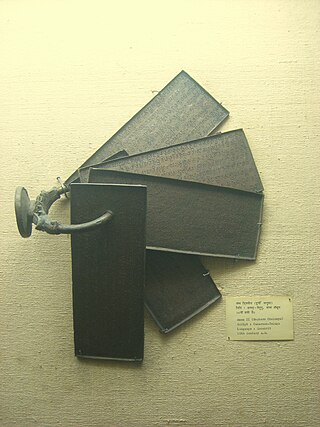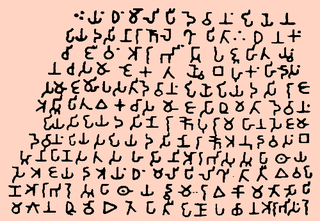
Sanchi Stupa is a Buddhist complex, famous for its Great Stupa, on a hilltop at Sanchi Town in Raisen District of the State of Madhya Pradesh, India. It is located, about 23 kilometers from Raisen town, district headquarter and 46 kilometres (29 mi) north-east of Bhopal, capital of Madhya Pradesh.

Brahmi is a writing system from ancient India that appeared as a fully developed script in the 3rd century BCE. Its descendants, the Brahmic scripts, continue to be used today across South and Southeastern Asia.

Kharosthi script, also known as the Gandhari script, was an ancient Indic script used by various peoples from the north-western outskirts of the Indian subcontinent to Central Asia via Afghanistan. An abugida, it was introduced by the middle of the 3rd century BCE, possibly during the 4th century BCE, and remained in use until it died out in its homeland around the 3rd century CE.

The Satavahanas, also referred to as the Andhras in the Puranas, were an ancient Indian dynasty. Most modern scholars believe that the Satavahana rule began in the late second century BCE and lasted until the early third century CE, although some assign the beginning of their rule to as early as the 3rd century BCE based on the Puranas, but uncorroborated by archaeological evidence. The Satavahana kingdom mainly comprised the present-day Andhra Pradesh, Telangana, and Maharashtra. At different times, their rule extended to parts of modern Gujarat, Madhya Pradesh, and Karnataka. The dynasty had different capital cities at different times, including Kotalingala (Telangana), Pratishthana (Paithan) and Amaravati (Dharanikota).

The Mathura lion capital is an Indo-Scythian sandstone capital from Mathura in Northern India, dated to the first decade of the 1st century CE. It was consecrated under the rule of Rajuvula, one of the Northern Satraps of the region of Mathura.

Bharhut is a village in the Satna district of Madhya Pradesh, central India. It is known for a Buddhist stupa, unique in that each panel is explicitly labelled in Brahmi characters saying what the panel depicts. The major donor for the Bharhut stupa was King Dhanabhuti.

Bhattiprolu is a village in Bapatla district of the Indian state of Andhra Pradesh. It is the headquarters of Bhattiprolu mandal in Tenali revenue division. The Buddhist stupa in the village is one of the centrally protected monuments of national importance. One of the earliest evidence of Brahmi script in South India comes from Bhattiprolu. The script was written on an urn containing Buddha's relics. The script has been named Bhattiprolu script.

Nagarjunakonda is a historical town, now an island located near Nagarjuna Sagar in Palnadu district of the Indian state of Andhra Pradesh. It is one of India's richest Buddhist sites, and now lies almost entirely under the lake created by the Nagarjuna Sagar Dam. With the construction of the dam, the archaeological relics at Nagarjunakonda were submerged, and had to be excavated and transferred to higher land, which has become an island.

Tamil-Brahmi, also known as Tamili or Damili, was a variant of the Brahmi script in southern India. It was used to write inscriptions in Old Tamil. The Tamil-Brahmi script has been paleographically and stratigraphically dated between the third century BCE and the first century CE, and it constitutes the earliest known writing system evidenced in many parts of Tamil Nadu, Kerala, Andhra Pradesh and Sri Lanka. Tamil Brahmi inscriptions have been found on cave entrances, stone beds, potsherds, jar burials, coins, seals, and rings.

The earliest deciphered epigraphy found in the Indian subcontinent are the Edicts of Ashoka of the 3rd century BCE, in the Brahmi script.

The Telugu–Kannada script was a writing system used in Southern India. Despite some significant differences, the scripts used for the Telugu and Kannada languages remain quite similar and highly mutually intelligible. Satavahanas and Chalukyas influenced the similarities between Telugu and Kannada scripts.
Afghanistan possesses a rich linguistic legacy of pre-Islamic scripts, which existed before being displaced by the Arabic alphabet, after the Islamic conquest of Afghanistan. Among these scripts are Sharada, Kharosthi, Greek, and Brāhmī. For thousands of years, Afghanistan was inhabited by Indo-Aryan and Iranian peoples and thus all ancient documents, tracts, monuments and remains are of Hindu and Iranian origins. Later, Buddhism became the major force in Afghanistan and brought with it its own liturgical languages.

Lipi means 'writing, letters, alphabet', and contextually refers to scripts, the art or manner of writing, or in modified form such as lipī to painting, decorating or anointing a surface to express something.

Prashasti is an Indian genre of inscriptions composed by poets in praise of their rulers. Most date from the 6th century CE onwards. Written in the form of poetry or ornate prose, the prashastis stereotypically constructed a genealogy, the ruler's attributes, eulogize victories, piety and typically ended with one or more announcements of generous gifts and rewards he has given. They differ from the so-called "Cultic" genre of Indian inscriptions which praise a deity, religious founder, guru, or sages then typically announces gifts or donations to a monastery, school, temple or a generous cause. In some epigraphic literature, a prashasti is considered synonymous with a kirti or purva, and is related to the word kirtana which implies "songs and praises of" someone or a deity.
The Northern Satraps, or sometimes Satraps of Mathura, or Northern Sakas, are a dynasty of Indo-Scythian ("Saka") rulers who held sway over the area of Punjab and Mathura after the decline of the Indo-Greeks, from the end of the 1st century BCE to the 2nd century CE. They are called "Northern Satraps" in modern historiography to differentiate them from the "Western Satraps", who ruled in Sindh, Gujarat and Malwa at roughly the same time and until the 4th century CE. They are thought to have replaced the last of the Indo-Greek kings in the Punjab region, as well as the Mitra dynasty and the Datta dynasty of local Indian rulers in Mathura.

The Stupa No. 2 at Sanchi, also called Sanchi II, is one of the oldest existing Buddhist stupas in India, and part of the Buddhist complex of Sanchi in Madhya Pradesh. It is of particular interest since it has the earliest known important displays of decorative reliefs in India, probably anterior to the reliefs at the Mahabodhi Temple in Bodh Gaya, or the reliefs of Bharhut. It displays what has been called "the oldest extensive stupa decoration in existence". Stupa II at Sanchi is therefore considered as the birthplace of Jataka illustrations.
Girihandu Seya is an ancient Buddhist temple situated in Thiriyai, Trincomalee, Sri Lanka. The temple is supposed to be the first Buddhist Stupa in Sri Lanka, believed to be constructed by two seafaring merchants Trapusa and Bahalika. The names of the two merchants are recorded in a rock inscription found in the Vihara premises. According to the inscription, Girihandu Seya was built by the guilds of merchants named Trapassuka and Vallika where the names are written as Tapassu and Bhalluka in later Sinhala chronicles. Some scholars also hold the view that Mahayana influenced seafaring merchants from the Pallava Kingdom were responsible for the construction of this temple.

The Nasik inscription of Ushavadata is an inscription made in the Nasik Caves by Ushavadata, a son-in-law of the Western Satraps ruler Nahapana, in the years circa 120 CE. It is the earliest known instance of the usage of Sanskrit, although a rather hybrid form, in western India. It also documents the Indian tradition of dana (charity) to Buddhist monks and of building infrastructure to serve pilgrims and the general public by the 2nd-century CE.

Ancient Indian scripts have been used in the history of the Indian subcontinent as writing systems. The Indian subcontinent consists of various separate linguistic communities, each of which share a common language and culture. The people of the ancient India wrote in many scripts which largely have common roots.

Sanskrit epigraphy is the study of ancient inscriptions in Sanskrit. The inscriptions offer insight into the linguistic, cultural, and historical evolution of South Asia and its neighbors. Early inscriptions, such as those from the 1st century BCE in Ayodhya and Hathibada, are written in Brahmi script and reflect the transition to classical Sanskrit. The Mathura inscriptions from the 1st and 2nd centuries CE, including the Mora Well and Vasu Doorjamb inscriptions, represent significant contributions to the early use of Sanskrit, often linked to Hindu and Jaina traditions.



















